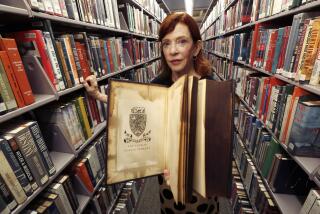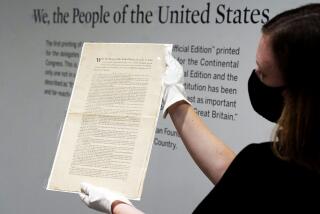Digital version of Gutenberg Bible available
- Share via
WASHINGTON — Most people will never see a Gutenberg Bible outside a dimly lighted display case. They won’t smell the sweet, musty aroma of the rippled cowhide vellum or use a magnifying glass to examine the engraved brass clasps or the strokes of hand-painted letters.
What they can do, thanks to high-resolution digital photography and a new generation of home computers, is explore the 548-year-old work by popping discs into their CD drives.
Viewers can use the zoom tool to enlarge sections of printed text or the hand-tooled leather binding. And they can search for a word in the English translation and, with a mouse click, go to the original page where the word appears in the Latin text.
Digitizing the Gutenberg Bible, the first book printed in the West on movable metal type, has made the “otherwise unavailable text available and in ways that before were unimaginable,” said Mark Dimunation, chief of the rare books and special collections division at the Library of Congress.
The library’s Gutenberg is one of 20 complete copies of the 1,286-page text and one of a dozen of 48 existing copies printed on vellum, a fine writing material made from animal skins, Gutenberg scholar Janet Ing Freeman said by e-mail from London.
It was acquired in 1930 as part of the $1.5-million purchase of more than 3,000 items from a German rare-book dealer.
Because the Bible is bound in three volumes, just one volume can be displayed in the Great Hall while the others “rest,” in conservators’ terms. They are rotated once every three to four months.
Technicians from Octavo, based in Berkeley, Calif., spent four months last year photographing the Library of Congress’ Gutenberg for its just-released two-CD digital facsimile. Octavo was created six years ago by John Warnock, who co-founded Adobe Systems 20 years ago and helped develop such commonly used text and graphics software as Acrobat Reader, Photoshop and Illustrator.
Warnock chairs the boards of Adobe and Octavo, but the two companies “have no legal connection,” said E.M. Ginger, Octavo’s executive editor.
Warnock, an avid book collector, started Octavo after realizing the computer technology he helped design could reproduce rare books digitally and affordably, Ginger said.
He began photographing 16th and 17th century scientific texts from his personal library. The company has since published more than 40 rare texts on CD in architecture, literature, art, geography, mathematics and other categories, she said.
The Gutenberg Bible was the eighth project that Octavo completed in partnership with the Library of Congress, including a treatise by 16th century architect Andrea Palladio and a 19th century collection of rose paintings by French artist Pierre Joseph Redoute.
Four years ago, Octavo set up an imaging studio off the rare-book reading room, where imaging specialist Arthur Brown is photographing English poet Edward Young’s “Night Thoughts” (1820), engraved and hand-colored by William Blake. The project is scheduled for fall publication.
The Gutenberg Bible was photographed in a different location under strict supervision of a conservator and rigorous environmental controls.
Octavo has worked with more than a dozen other libraries and collections, including the Folger Shakespeare Library, the New York Public Library, the Chicago Botanic Garden and the Bridwell theological library at Southern Methodist University in Dallas.
Most of the world’s major libraries are digitizing texts, and “there’s probably more being done in biblical studies ... than in any other field,” said Kent Richards, executive editor of the Atlanta-based Society of Biblical Literature.
Richards said scholars and librarians are debating whether digital facsimiles should be free to anyone with Internet access or sold on compact discs, the way Octavo is doing it.
Ginger said her company “has yet to make a profit.” Octavo’s goal is to make the Gutenberg Bible and other rare books accessible to as wide an audience as possible and “to keep the price as low as we can.”
The two-CD Gutenberg set is $65, but the price will go up to $80 in October -- about what a moderately priced art book would cost, she said. (A research facsimile with massive image files is available on 28 CDs for $1,500 now and $1,950 in the fall.) Ginger said all Gutenberg images can be viewed on Octavo’s Web site but cannot yet be magnified there as they can on the CD.
More to Read
Sign up for our Book Club newsletter
Get the latest news, events and more from the Los Angeles Times Book Club, and help us get L.A. reading and talking.
You may occasionally receive promotional content from the Los Angeles Times.









